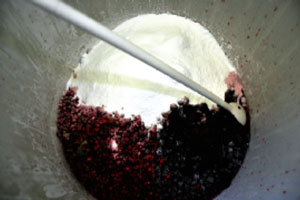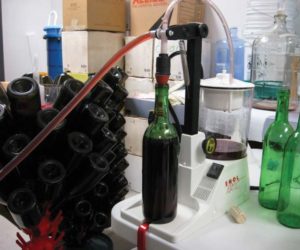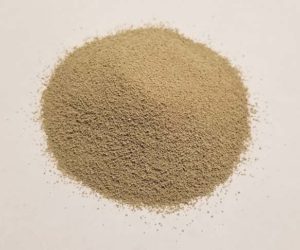Q
I have started to make small batches of fruit wine in the 1 to 2 gallon (3.8–8.5 L) range. When it comes to clarifying I use a pre-measured packet that I got from a supplier. The amounts are what are used for 5 to 6 gallons (19–23 L) of wine. Is there a rule of thumb on the amount that should be used for each gallon of wine that needs to be clarified? Can I just use the pre-measured packages for 1 or 2 gallons (3.8–8.5 L) without affecting the taste?
Bruce Castrato
Wausakee, Wisconsin
A
The short answer is that yes, I would absolutely cut down on the amount of clarifying agent you use if you don’t have enough wine volume for the recommended 5 gallon (19 L) batch listed on the packet. Because I don’t know what is in your “pre-measured packet,” it’s hard for me to get into express chemical details of what such little packets might do to your wine if added in excess amounts, but suffice it to say that as with adding anything to wine, tread with caution and be conservative.
Wine clarifiers, or “fining agents” as they (and a whole host of other wine-finishing additives) are called, are creatures of degrees. What I mean is that they enact some sort of chemical or physical activity on one’s wine, usually binding to and settling out of solution some unwanted compound (excess tannin, cloudy protein, etc.) in the finished wine, usually on a sliding scale. Add too little and, in your case, you may not see the clarity that you would want. Add too much, and you’ll get clarity in spades, but perhaps strip out aroma, color or mouthfeel that you would’ve rather kept.
This is why, no matter what the additive or step, I always advocate “bench trials” first in winemaking. Bench trials are small-scale trials, little lab experiments if you will, where one measures out a little bit of wine and a little bit of the additive, carefully weighed or pipetted, and tries out a range of additive for effect. Once the desired result has been tested and tasted the treatment is then multiplied up to correspond to the total batch volume. Though it may seem a little tedious, well-measured bench trials, backed up by careful note taking and record keeping, are what build up the experience and skill set of the winemaker as well as, more immediately and obviously, prevents batch-ruining disasters.
Sometimes we don’t have the equipment, time or patience to do bench trials, however. Especially when measuring tiny amounts of an additive, one often needs specialist equipment like a gram scale that will go to tenths or hundredths of a gram, and micro-pipettes for measuring liquid additives. Expensive equipment, I know, but a purchase that can often be shared between members of a winemaking club or group of friends. However, what you’re doing, making up wines in very small batches (1–2 gallons/3.8–8.5 L instead of a full 15-gallon (57-L) keg or full barrel) and then seeing how they come out with different treatments is another wise way to proceed. Be sure to take notes as you go along so you get a sense of what works and what doesn’t, what pleases you and what you can live without. Your “bench trial” for your clarifying agent could be to test the clarifying power of half of a packet (presumably a 2.5-gallon (9.5-L) dose, if it reads that it is sized for 5) or even a quarter of a packet. You may be surprised by what works the best for you because often the manufacturer’s recommended dose is simply an arbitrary range based on their experience. Because each batch of wine is different and each situation unique, you may find you need a lot of one fining agent, or very little of another. Experimenting with bench trials are best when trying anything new in your winery, but when you can’t or don’t want to do them, a conservative step-wise approach to adding anything to our wines, be it tartaric acid, bentonite or even barrel time, is often just as good.
Q
Although I live in Victoria, British Columbia I use California grapes, and this year our winemaking group purchased 8.5 tons. However the pH was all over the map and I am wondering whether or not you could answer the following questions. The “old vine” California Zinfandel grapes tested out as follows: 21 °Brix, pH 3.97, TA 6.2. First question: Is it reasonable to assume the pH from these fields would have been similar last year and would be the same next year? Or can pH be all over the map from year to year from the same fields? The Cabernet Sauvignon had a pH of 3.67, Brix of 22.5 and a TA of 6.0. The Merlot had a pH of 3.8, Brix of 23.4 and a TA of 6.0. In all cases I added tartaric acid to reduce the pH for a total of 4.0 cc per liter for the Zinfandel, 2.5 cc per liter for the Cabernet and 3.0 cc per liter for the Merlot. I would very much appreciate your comments as I am having a serious argument (perhaps a misunderstanding) with the supplier who calls these grapes “premium.” Should grapes with a pH as high as this still be promoted as “premium,” which has also attracted a premium price.
Jim Neame (and the rest of our group)
Victoria, British Columbia
A
That’s an interesting data set you present there. What I’m about to tell you, please take with many grains of salt because I am not privy to the growing locations of your California Zinfandel, Cabernet Sauvignon and Merlot grapes and, for instance, would expect very different quality numbers from a Zinfandel grown in Dry Creek Valley in Sonoma County vs. a Zinfandel (especially one grown for White Zinfandel purposes) from the Central Valley of California. Before I go too much farther, let me state that you must keep liberally applying said salt shaker because I’m not privy to the details of your purchase contract and your own expectations of what’s acceptable quality for you. What I’m about to tell you is only my opinion; if you wish to employ me as a legal witness to testify in court, please contact my editors at WineMaker magazine (tongue firmly in cheek. . .). That all being said: I think you have a Brix problem as well as a pH problem . . . and perhaps a “relationship problem.”
Let’s start with your first question: Can pHs vary all over the map from year to year, even if the grapes are from the same field? pHs can certainly have a range of variation from year to year but I would come to expect that fruit coming from the same block within the same vineyard, when the grapes were picked at the same judge of ripeness within a winemaker’s acceptable “pick window,” would maybe range say, between 3.55–3.65. You notice there were a lot of “sames” in that last sentence. This is really critical because I can also say I’ve seen for the same varietal (say Pinot Noir to Pinot Noir) within the same vineyard, but different clones and different blocks, really vary in pH, perhaps from 3.55–3.85. I’ve got blocks and clones where I know that they vary this way, so this is what I expect. I suspect that you, being so distant from your source and perhaps not in the best communication with your grower, may not have this kind of insight into where your grapes are coming from. This is why it’s tough to pass judgment on your particular situation as to what kind of pH variation you can expect year to year. If you’re not sure you are getting your grapes from the exact same vineyard block every year, there indeed can be some wide variations in pH, which will also differ with the weather, water content of the soil, health of the vine and many other factors in addition to those mentioned above.
A grape’s “numbers” (Brix, pH, TA, etc.) are also very much dependent on when the winemaker decides to pick said grapes. As a grape cluster matures towards the “harvest window” (usually a week or two-week period where I would consider ripeness factors at their optimum for quality still winemaking), the sugar level increases and acids decrease. Tannins “ripen” and become softer, green flavors and aromas decrease (which is why you shouldn’t just judge your grapes based on numbers alone, but how they taste as well). Hopefully the weather cooperates (and you don’t have to pick early due to impending rain) and the winemaker works with the grower to bring the grapes to the winery at a time that is amenable to both parties. If you are not there in the field “calling the pick” with the grower and the grower is making the picking decision with no input from you, it’s reasonable to expect that the pH can range “all over the map” as you put it.
To address what I assume is your second question: Are your grapes in the zone of what I would call “premium”? Lest I take a major digression into the fuzzy world of wine marketing, there is no industry definition of “premium” that everyone agrees on and it is very much a buzzword to be thrown about. I’ve seen it define 750 mL bottles of wine anywhere in the $5 to $20 category and used extremely subjectively. That being said, just judging by the numbers, I wouldn’t call your Zinfandel in an especially “premium” range. With a Brix of 21, something tells me that that fruit just didn’t get ripe, but a pH of 3.97 is curiously high, a number typically seen in “over-ripe” situations. Such a low Brix with such a high pH (but with a decent TA of 6.2) raises a lot of questions for me. I would wonder about the accuracy of the data and if it were my lot of grapes, I would have my lab re-run them to double check each result’s accuracy. You should also check your own equipment — most importantly your pH meter — to be sure that everything is properly calibrated. All too often improperly calibrated equipment is a source of incorrect data. (For more about calibrating your winemaking tools, visit www.winemakermag.com/component/resource/article/127.) I would wonder if the vineyard was possibly “over-cropped,” that is, if the grower hung 7 tons or more to the acre, well over the usual “premium” quality level of 5 tons to the acre or under. Also, if the grapes are from California’s Central Valley or warmer inland areas, there’s a chance they were planted to produce White Zinfandel (the classic California “pink wine”), in which case using clones and rootstocks that are intended to be high volume, low Brix and low color and “character” producers. I even speculate if the vineyard may be affected by “red blotch virus,” the newest grapevine disease to rear its ugly head, a symptom of which is an inability to accumulate sugar (get to an acceptable Brix for winemaking) even as pH increases. Leaf roll virus is also another pathogen that can cause this outcome. In short, I would not consider your Zinfandel numbers to be a great combination for quality winemaking and if it was delivered to my doorstep I would reject the load or at the very least have a heart-to-heart with my grower and talk about getting out of or re-negotiating the terms of that supply contract.
However, you’ve received the grapes and crushed them, and unfortunately there is little you can do about it now except look to the next harvest. You may have never heard me say it here but I have always believed that, “winemaking begins with people” and not with grapes, as so many say. The people part here is your relationship with your supplier; you may have to work a little harder to be proactive with him or her in order to let them know what you are looking for. Perhaps going into subsequent harvests you can give them some direction as to number ranges and expectations so they have something to perform against. Don’t forget that growers and winemakers can sometimes have an inherent conflict of interests; winemakers want maximum ripeness of flavor, whereas growers want to get paid by the ton and get their fruit safely off the vine and to their clients. Often, as winemakers delay picking in order to maximize ripeness, the clusters can dehydrate and start to lose weight and start to disintegrate. Try to sympathize with a farmer watching her produce essentially rot in the field while a picky winemaking client keeps wanting to delay harvest in hopes of achieving that super-ripe style or flavor that some of us try to achieve in our wines. Growers need to also put themselves in the winemaker’s shoes. In your case with the Zinfandel, I can see why you may have been disappointed.
I find that, barring the ability to get into the vineyard and actually taste the grapes before they are harvested (which I assume is not a possibility for you, given your distance), pH and Brix are my two most important number-driven predictors of quality. I like to see red grapes come in 23.5–25.0 Brix and pH between 3.45–3.75. The numbers on your Cabernet and Merlot (though the Merlot pH is a wee bit on the high side) are more reasonable than the Zinfandel, but I still think your Brix readings are quite low. Don’t, however, just assume a grape is “lower quality” because of a number range; remember that you need to judge a lot of grapes holistically on many attributes including color, flavor, tannin level and microbial soundness, not just Brix, pH and TA. Likewise it shouldn’t be forgotten that you are paying a lot of money for your grapes and 8.5 tons is not an insignificant amount to be buying. You should certainly stand up for quality in order to get what you are paying for, but be prepared to treat your grower as a partner. You both will probably have to give a little to get what you want.
Q
I was hoping you could help us out with a “cleaning” question. We have a home winemaker’s center, and we use potassium metabisulfite to clean all of our equipment, etc. However, we have some deep discussions on what is acceptable to use to clean our floors. We currently use bleach but we want to make sure this is OK, and does not have any adverse effects we are not thinking of. We of course wash the floors so that there is no residual bleach, but I want to make absolutely sure.
Gianni FabrizI
Hicksville, New York
A
My rule is no chlorine bleach in my wineries, never, nohow. Anything containing chlorine might contribute to the dreaded “corked wine aroma,” 2-4-6 trichloroanisole (TCA), in your finished wines. It can be a convoluted pathway, but certain indigenous molds in your cellar or in wine corks can metabolize free chlorine molecules into this stinky, swampy aroma that some say can affect up to one in twenty (though in my experience it’s a lot fewer) bottles of wine in supermarket shelves these days. This is also, incidentally, why we should all filter the water we use in winemaking so it’s chlorine-free, if at all possible or practical. So I would like to see you take chlorine bleach and bleached products out of your cellar cleaning and sanitizing regimen. Go with something like PBW (powdered brewery wash — available from many hobby winemaking suppliers).
By the way, potassium metabisulfite can be a great sanitizing agent, but please don’t forget it is technically that — a microbe-reducer and not a cleaning chemical per se. Cleaning agents get rid of scale, dirt and grime whereas sanitizers need to be applied to an already-clean surface for maximum effectiveness. Just make sure that your cleaning and sanitizing compounds don’t contain any chlorine.







